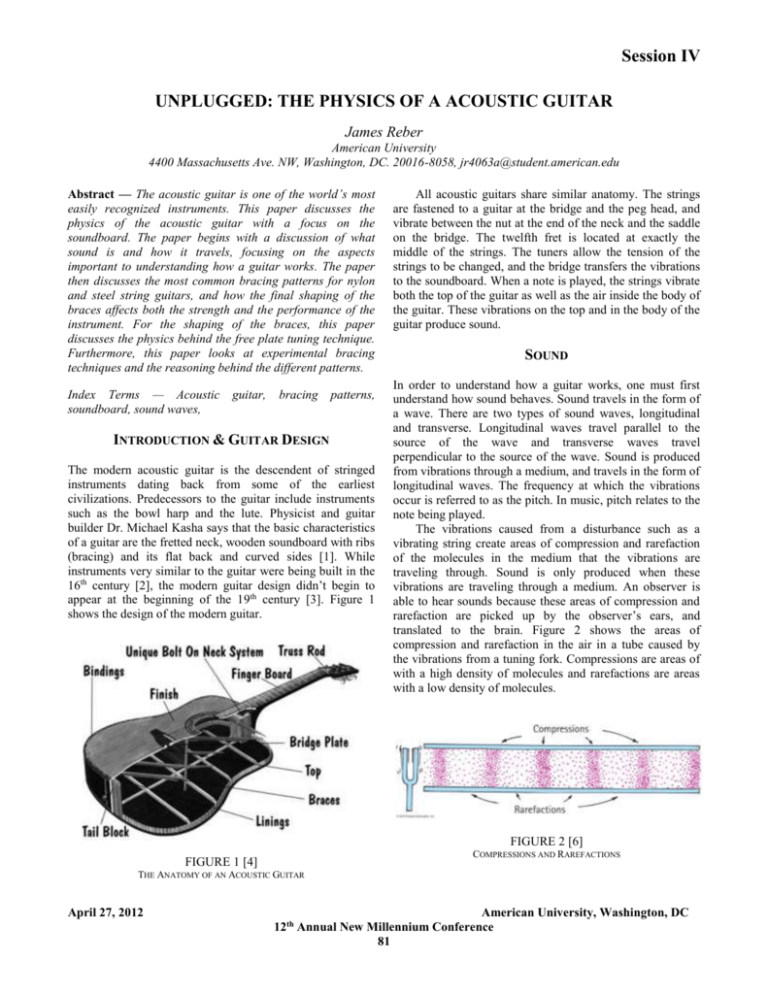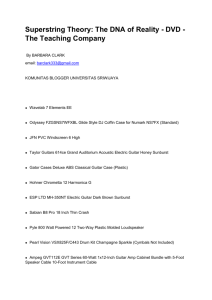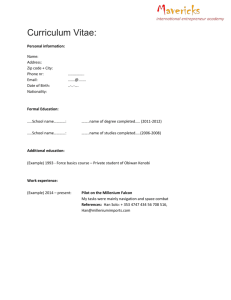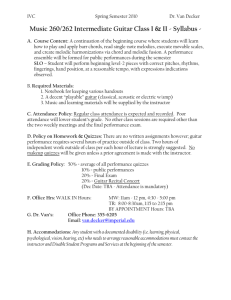
Session IV
UNPLUGGED: THE PHYSICS OF A ACOUSTIC GUITAR
James Reber
American University
4400 Massachusetts Ave. NW, Washington, DC. 20016-8058, jr4063a@student.american.edu
Abstract — The acoustic guitar is one of the world’s most
easily recognized instruments. This paper discusses the
physics of the acoustic guitar with a focus on the
soundboard. The paper begins with a discussion of what
sound is and how it travels, focusing on the aspects
important to understanding how a guitar works. The paper
then discusses the most common bracing patterns for nylon
and steel string guitars, and how the final shaping of the
braces affects both the strength and the performance of the
instrument. For the shaping of the braces, this paper
discusses the physics behind the free plate tuning technique.
Furthermore, this paper looks at experimental bracing
techniques and the reasoning behind the different patterns.
Index Terms — Acoustic
soundboard, sound waves,
guitar,
bracing
patterns,
INTRODUCTION & GUITAR DESIGN
The modern acoustic guitar is the descendent of stringed
instruments dating back from some of the earliest
civilizations. Predecessors to the guitar include instruments
such as the bowl harp and the lute. Physicist and guitar
builder Dr. Michael Kasha says that the basic characteristics
of a guitar are the fretted neck, wooden soundboard with ribs
(bracing) and its flat back and curved sides [1]. While
instruments very similar to the guitar were being built in the
16th century [2], the modern guitar design didn’t begin to
appear at the beginning of the 19th century [3]. Figure 1
shows the design of the modern guitar.
All acoustic guitars share similar anatomy. The strings
are fastened to a guitar at the bridge and the peg head, and
vibrate between the nut at the end of the neck and the saddle
on the bridge. The twelfth fret is located at exactly the
middle of the strings. The tuners allow the tension of the
strings to be changed, and the bridge transfers the vibrations
to the soundboard. When a note is played, the strings vibrate
both the top of the guitar as well as the air inside the body of
the guitar. These vibrations on the top and in the body of the
guitar produce sound.
SOUND
In order to understand how a guitar works, one must first
understand how sound behaves. Sound travels in the form of
a wave. There are two types of sound waves, longitudinal
and transverse. Longitudinal waves travel parallel to the
source of the wave and transverse waves travel
perpendicular to the source of the wave. Sound is produced
from vibrations through a medium, and travels in the form of
longitudinal waves. The frequency at which the vibrations
occur is referred to as the pitch. In music, pitch relates to the
note being played.
The vibrations caused from a disturbance such as a
vibrating string create areas of compression and rarefaction
of the molecules in the medium that the vibrations are
traveling through. Sound is only produced when these
vibrations are traveling through a medium. An observer is
able to hear sounds because these areas of compression and
rarefaction are picked up by the observer’s ears, and
translated to the brain. Figure 2 shows the areas of
compression and rarefaction in the air in a tube caused by
the vibrations from a tuning fork. Compressions are areas of
with a high density of molecules and rarefactions are areas
with a low density of molecules.
FIGURE 2 [6]
COMPRESSIONS AND RAREFACTIONS
FIGURE 1 [4]
THE ANATOMY OF AN ACOUSTIC GUITAR
April 27, 2012
American University, Washington, DC
12th Annual New Millennium Conference
81
Session IV
FORCED VIBRATIONS
(3)
The volume of a sound depends on the amount of air that is
moving due to the vibrations created from the sound source.
When an object that is vibrating is held against another
object, the second object will also vibrate. This is called
forced vibration. If the second object has a larger surface
area, the vibrations will move more air, making the volume
louder. One of the main physics principles that apply to an
acoustic guitar is forced vibrations. Forced vibrations occur
when a vibrating object forces another object to vibrate.
Hewitt uses the example of a tuning fork placed on a table.
The vibrating tuning fork forces the table to vibrate at the
same frequency. The vibrating table moves more air
molecules than the tuning fork alone, and therefore produces
a higher volume [7]. On a guitar, the vibration of the strings
is transferred to the soundboard through the bridge, forcing
the soundboard to vibrate at the same frequency as the
string, which produces sound.
HOW A GUITAR FUNCTIONS
There are two different kinds of guitars: classical and folk.
The main difference between a classical and a folk guitar is
the type of strings used. Classical guitars use nylon strings
and folk guitars use steel strings. Both types of guitars are
tuned to the same frequencies, but the nylon strings have a
much lower density than steel strings, and therefore the
tension on the soundboard of the guitar is much less for a
classical guitar than a folk guitar. The bracing for a steel
string guitar must be much stronger than the bracing of a
classical guitar in order to handle the increased force on the
soundboard due to the steel strings.
When a note is played on the guitar, the string vibrates
back and fourth producing a wave. The frequency of the note
is determined by the velocity of the wave on the string
divided by the wavelength, shown in (1).
(1)
A guitar has six strings, each one of a different thickness and
tuned to a different frequency. The strings must be different
thicknesses because the velocity of a wave on a string
depends on the tension, and the linear mass density of the
string, shown in (2), where is the velocity, is the tension
and is the linear mass density. The thicker strings have a
lower frequency, and the thinner strings have a higher
frequency. This is because thicker strings have a higher
linear mass density, which reduces the velocity of the wave
on the string for a given tension, and the result is a lower
frequency. Linear mass density is expressed in (3), where
is the mass of the string and is the length of the string.
April 27, 2012
Regardless of whether or not a guitar is strung with
nylon or steel strings, the frequency of the open strings, or
the frequency produced when a string is not fretted, is not
changed. Depending on the size of the instrument (and
therefore the wavelength of the string), the velocity will
change. For a given frequency, a long wavelength means a
lower velocity, and a short wavelength means a higher
velocity. The strings on all guitars in standard tuning are
tuned to the same frequencies, despite the length of the
strings. Small guitars are tuned to the same frequencies as
larger guitars. Table 1 shows the pitch as well as the
frequencies of a guitar in standard tuning. The number after
the letter name of the pitch refers to the octave at which the
pitch is heard [8].
TABLE 1
GUITAR STRING NOTES AND FREQUENCIES
String
1
2
3
4
5
6
Pitch
E2
A2
D3
G3
B3
E4
Frequency
82 Hz
110 Hz
147 Hz
196 Hz
243 Hz
330 Hz
The tension on the bridge of the guitar due to the strings
varies depending on the material of the strings due to the
change in the linear mass density. Table 2 compares the
tension of the most common gauge of nylon and steel
strings. The tensions shown in Table 2 are based on the most
common scale length of each style of guitar; 25.6 for nylon,
25.4 for steel.
TABLE 2 [9]
NYLON AND STEEL STRING TENSIONS
String
1st E
2nd A
3rd D
4th G
5th B
6th E
Total
Nylon (Normal Tension)
14 Lbs
15 Lbs
15.6 Lbs
12.1 Lbs
11.6 Lbs
15.3 Lbs
83.6 Lbs
Steel (Light Gauge)
25.1 Lbs
28.4 Lbs
29.5 Lbs
29.4 Lbs
23.3 Lbs
23.3 Lbs
159 Lbs
In order to change the note being played, the player
changes the wavelength of the string by shortening the
length of the string with their fingers. The velocity of the
wave on the string remains constant, and by shortening the
length of the string the frequency increases [10].
The wavelength for a string on a guitar depends on the
(2)
scale length of a guitar, or the distance from the nut near the
headstock of the guitar to the saddle on the bridge, with the
American University, Washington, DC
12th Annual New Millennium Conference
82
Session IV
twelfth fret being in the middle. The first harmonic, or the
fundamental, shown in Figure 3 shows the motion of a
plucked open string (vibrating between the nut and the
saddle), which is half the wavelength of the wave on the
string. This is known as the first harmonic. Harmonics are
whole number multiples of the fundamental frequency. The
second harmonic is formed on a guitar by creating a node at
the twelfth fret and is twice the frequency of the open string.
Creating a node at the fifth or seventeenth fret forms the
third harmonic and the frequency is three times higher than
the open string [11].
vibration of the air inside the body of the guitar as well as
the high frequencies projected from the vibration of the
soundboard gives the guitar its unique sound.
THE OVERTONE SERIES
Every instrument’s sound quality or timbre is different due
to the instrument’s unique overtone series. When a note is
played on a guitar, the pitch that is heard is the fundamental
frequency. There is also a combination of other frequencies,
known as partial tones or harmonics, which are emitted
along with the fundamental frequency. The volumes of these
partial tones affect the timbre or tone of the instrument. The
amount of partial tones and the volume of each partial tone
for a note make every instrument sound different. The
combination of these partial tones is known as the overtone
series [14]. Figure 4 shows an example of the amplitude of
the different frequencies produced from a single note played
on a guitar, with the first peak being the fundamental
frequency. The x-axis shows the frequency of each overtone
and the y-axis shows the intensity of each of those
frequencies.
FIGURE 3 [12]
WAVES ON A GUITAR STRING
There are two different phenomena that make the
conversion of the mechanical energy from the player
plucking a string to sound energy more efficient, and
therefore louder. Dr. Wolfe notes that a guitar does not
amplify the sound from the vibrations of the strings. First,
when the string vibrates above the sound hole of the guitar,
the vibrations of the strings create areas of compressions and
rarefaction in the air around the sound hole. These vibrations
compress the air inside the body of the guitar, which raises
the internal pressure. The air is then forced out due to the
high pressure. This is referred to as Helmholtz resonance.
The vibration of the air inside the body of a guitar mostly
affects the lower frequencies, so a guitar with a smaller body
would produce softer low frequencies. This becomes
apparent when looking at the violin family of instruments.
The lower pitched instruments such as the cello or bass have
larger bodies than the violin of viola.
The other way that a guitar converts the mechanical
energy to sound energy is through the vibration of the top of
the guitar. The top or soundboard is designed to vibrate, and
because of its large surface area, the vibrations move more
air than the string alone could. The vibrating soundboard is
an example of forced vibrations. The strings vibrate against
the bridge, which forces the soundboard to vibrate. The
soundboard projects the higher frequencies of a guitar into
the air around the guitar. The more surface area of the
soundboard, the louder the produced frequencies are [13].
The combination of the low frequencies projected from the
April 27, 2012
FIGURE 4 [15]
GUITAR OVERTONE SERIES
The overtone series is unique for not only every
instrument, but also every guitar. There are several
components that affect the overtone series of a guitar, from
the woods used for the instrument to how the strings are
plucked. Arguably the leading factor that affects the
overtone series of a guitar is the bracing on the underside of
the soundboard.
SOUNDBOARD BRACING
The purpose of the bracing of a guitar is to both provide
support against the soundboard warping due to the tension of
the strings as well as help transfer the vibrations of the
strings to the soundboard. Ideally, the bracing transfers the
vibration of the strings to the entire soundboard of the
instrument.
In about 1850 Antonio Torres of Spain introduced a
fanned bracing pattern on his nylon string guitars. His
American University, Washington, DC
12th Annual New Millennium Conference
83
Session IV
bracing pattern provided sufficient strength to the
soundboard of the guitar as well as enhanced the tone of the
instrument. This pattern has remained one of the most
common bracing techniques used for classical guitars to this
day [15]. Figure 5 shows the Torres bracing pattern.
FIGURE 5 [16]
TORRES BRACING PATTERN
Steel guitar strings began to become available by the
early 20th century and proved to provide louder volumes than
nylon strings. While Torres’ pattern was sufficient for nylon
strings, the increased tension of the steel strings was too high
and caused the soundboard to warp. To compensate for this,
guitar builders began using an X bracing pattern, which
provided more support for the soundboard. Christian Martin
who founded C.F. Martin guitars in the 1830’s was an
innovator of the X bracing pattern [17]. Figure 6 shows
Martin’s X bracing pattern.
soundboard with bracing because the soundboard would be
free to vibrate, but the tension of the strings would cause the
wood to warp, making the instrument unplayable. Guitar
builder Bert Eendebak explains that the structural
requirements of a guitar harm the musical quality of the
instrument [18].
The soundboard of a guitar oscillates in different
patterns depending on the frequency of the note being
played. One way to visualize these patterns is with Chladni
figures. Chladni figures provide a visual reference for where
the nodes are located. When the soundboard is vibrating at a
certain frequency, there are areas that on the soundboard that
do not vibrate due to standing waves, or stationary waves.
Standing waves occur when two opposing waves of the same
wavelength and amplitude meet and cancel. When a material
such as sand or some kind of power is placed on a plate (or
soundboard) that is vibrating at a certain frequency, it is
attracted to the areas that are not moving, or nodes [19].
Figure 7 shows and example of two nodes marked “N”.
FIGURE 7 [20]
NODES
The nodes are formed on a guitar soundboard when
waves encounter each other and cancel. Even if one note is
plucked on a guitar string, the interference of the vibrations
on the soundboard still form nodes. Figure 8 shows how the
interference between waves of the same wavelength forms
nodes. The green and blue lines represent two interfering
waves and the red line shows the amplitude of the resulting
waveform.
FIGURE 6 [18]
MARTIN X BRACING
Martin’s X bracing pattern has remained the standard
for steel string guitar bracing while Torres’ fan bracing
pattern has remained the standard for nylon string guitars.
VIBRATIONS ON THE SOUNDBOARD OF A GUITAR
The soundboard of a guitar is designed to oscillate due to the
vibrations of the strings. The more that the soundboard is
able to flex, the more volume the instrument produces
because of the higher amount of air being vibrated. A
soundboard with no bracing would be much louder than a
April 27, 2012
FIGURE 8 [21]
NODES FORMED BY WAVE INTERFERENCE
Figure 8 shows nodes created from waves traveling in one
dimension. Waves on the soundboard of a guitar travel in
American University, Washington, DC
12th Annual New Millennium Conference
84
Session IV
two dimensions. Figure 9 shows the pattern of the nodes
formed on a guitar soundboard at 77 Hz, 375 Hz and 511
Hz. These patterns are examples of Chladni patterns on the
soundboard of a guitar. The black lines show the areas of no
vibration or the nodes on the soundboard.
Once the frequency that forms the ring-and-a-half
pattern is found, the braces on the soundboard can be shaped
to improve the pattern. The goal is to have a perfect circle
below the sound hole where the bridge is attached as well as
a perfectly curved line above the sound hole [25]. By
changing the height and width of the braces, the resistance
against flexing is changed. A thinner brace will flex more
than a thick brace. Equation (4) shows the relationship of
how height and width of a brace affects the resistance
against bowing, where is the resistance,
is the width of
the brace and is the height of the brace [26].
(4)
FIGURE 9 [22]
NODES ON A GUITAR
Chladni figures can be helpful in guitar construction.
Guitar builders can use the patterns to determine how the
bracing on the soundboard needs to be altered. Altering the
bracing on the soundboard until a desired chladni pattern is
found is referred to as free plate tuning.
FREE PLATE TUNING
While the patterns formed on the soundboard depend on the
shape and material of the soundboard, the patterns can be
useful for the final shaping of the braces. While the main
purpose of the braces is to provide structural support for the
soundboard, they also help transmit the vibration of the
strings to the entire soundboard. The braces must be shaped
in such a way that the stiffness to mass ratio of the
soundboard is the same in all directions.
One method of ensuring that the stiffness to mass ratio
is consistent along the soundboard is by using the ring-anda-half method. In order to use this method, the soundboard is
vibrated at different frequencies until a Chladni figure forms
where the nodes form a ring below the sound hole, and half a
ring above the sound hole. The frequency at which this
pattern occurs varies depending on the soundboard being
tested [23]. Figure 10 shows a pattern very close to the ringand-a-half pattern.
When constructing the soundboard for a guitar, the
braces are shaved down, reducing the resistance against flex,
until the ring-and-a-half pattern is perfect. When the ringand-a-half pattern is perfect, the stiffness to mass ratio of the
soundboard is isotropic, or consistent across the entire
soundboard [27]. The thickness of the bracing also has effect
on the tone or timbre of a guitar. Guitars with heavy bracing
have better tone, but less volume. This is due to the fact that
the heavy bracing doesn’t allow the soundboard to vibrate as
well, therefore moving less air. Lighter bracing does not
transmit the vibration of the strings to the soundboard as
efficiently as thick bracing, but it allows the soundboard to
vibrate more because it is less stiff, producing more volume
[28].
EXPERIMENTAL BRACING PATTERNS
While the X bracing pattern for steel string guitars and the
fan-bracing pattern for nylon string guitars have been the
most commonly practiced bracing techniques, some guitar
builders have experimented with alternative bracing patterns.
One of these alternative patterns is the Kasha bracing pattern
for nylon string or classical guitars. In the 1960’s, Dr.
Michael Kasha created an asymmetrical bracing pattern that
he based on Chladni figures for circular plates. His goal was
to create a guitar that produced more volume and better tone
than classical guitars with the traditional fan bracing. Figure
11 shows Kasha’s bracing pattern.
FIGURE 11 [29]
FIGURE 10 [24]
THE KASHA SOUNDBOARD
RING-AND-A-HALF PATTERN
April 27, 2012
American University, Washington, DC
12th Annual New Millennium Conference
85
Session IV
Kasha’s design addressed the issue of heavy bracing
producing good tone but low volume and light bracing
producing high volume but poor tone. The lower notes on a
guitar have more amplitude due to their increased mass, and
therefore force the soundboard to vibrate more than the
higher notes make it vibrate. Kasha’s bracing pattern
simultaneously achieves the ideal conditions of heavy
bracing for low notes and light bracing for high notes [30].
SUMMARY
There are many elements that go into producing a quality
guitar. Both classical and folk guitar builders strive to
produce instruments with good tone as well as powerful
volume. While there is a lot to be said about the materials
used in constructing a guitar, one can argue that the bracing
is one of the most important aspects. Guitar builders, also
known as luthiers, are constantly making adjustments to the
standard X bracing and fan-bracing patterns in order to
create an instrument that creates ideal conditions for sound
to travel. The design of a guitar is based on several physics
concepts that can be utilized to produce an instrument of the
highest quality.
[21] Ref. 19.
[22] Ref. 19.
[23] Johnston, J. E. "The Theory Behind Free Plate Tuning Using
Chladni
Mode Patterns." Jack Johnston Guitar Maker. 27 Feb. 2011.
Web. 01
Mar.
2012.
<http://jackjohnstonguitarmaker.com/TheTheoryBehindFreePlat
eTuni
ngUsingChladniModePatterns.aspx>.
[24] Ref. 19.
[25] Ref. 23.
[26] Ref. 19.
[27] Ref. 23.
[28] Perlmeter, A, "Redesigning the Guitar." Science News 98.8/9
(1970):
180-81. JSTOR. Web. 15 Feb. 2012.
[29] Ref. 28.
[30] Ref. 28.
REFERENCES
[1] Kasha, M, "A New Look at The History of the Classic Guitar",
Guitar
Review, 30 Aug., 1968, pp.3-12.
[2] Tyler, J, “The Renaissance Guitar 1500-1600” Early Music, Vol. 3,
No.
4, Oct., 1975, pp. 341-347
[3] Guy, P, "A Brief History of the Guitar." Guitar Handbook. Paul
Guy
Guitars, 2001. Web. 27 Feb.
2012.
<http://www.guyguitars.com/eng/handbook/BriefHistory.html>.
[4] Wolfe, J, "How Does a Guitar Work?" How a Guitar Works.
University
New South Whales. Web. 29 Feb.
2012.
<http://www.phys.unsw.edu.au/music/guitar/guitarintro.html>.
[5] Ref. 4
[6] Hewitt, Paul G, Conceptual Physics, 11th ed. San Francisco:
Pearson
Addison Wesley, 2010.
[7] Ref. 6.
[8] Parker, B. R, Good Vibrations: The Physics of Music.
Baltimore:
Johns Hopkins UP, 2009. pp. 160-163
[9] Just Strings, Web. 29 Feb. 2012. <http://www.juststrings.com>.
[10] Ref. 8.
[11] Ref. 6.
[12] Ref. 6.
[13] Ref. 4.
[14] Ref. 6.
[15] Hokin, S. "The Physics of Everyday Stuff: The Guitar."
Bsharp.org.
2012. Web. 29 Feb. 2012.
<http://www.bsharp.org/physics/guitar>.
[15] Ref. 3.
[16] Usher, T. "The Spanish Guitar in the Nineteenth and
Twentieth
Centuries." The Galpin Society Journal 9 (1956): 5-36.
JSTOR. Web.
15 Feb. 2012.
[17] Ref. 3.
[18] Eendebak, B, "The Soundboard." Design of a Classical
Guitar.
2011. Web. 01 Mar.
2012.
<http://www.designofaclassicalguitar.com/soundboard.php>.
[19] Wolfe, J, "How Does a Guitar Work?" Chladni Patterns for
Guitar
Plates. University New South Whales. Web. 29 Feb.
2012.
<http://www.phys.unsw.edu.au/music/guitar/guitarintro.html>.
[20] Ref. 19.
April 27, 2012
American University, Washington, DC
12th Annual New Millennium Conference
86






